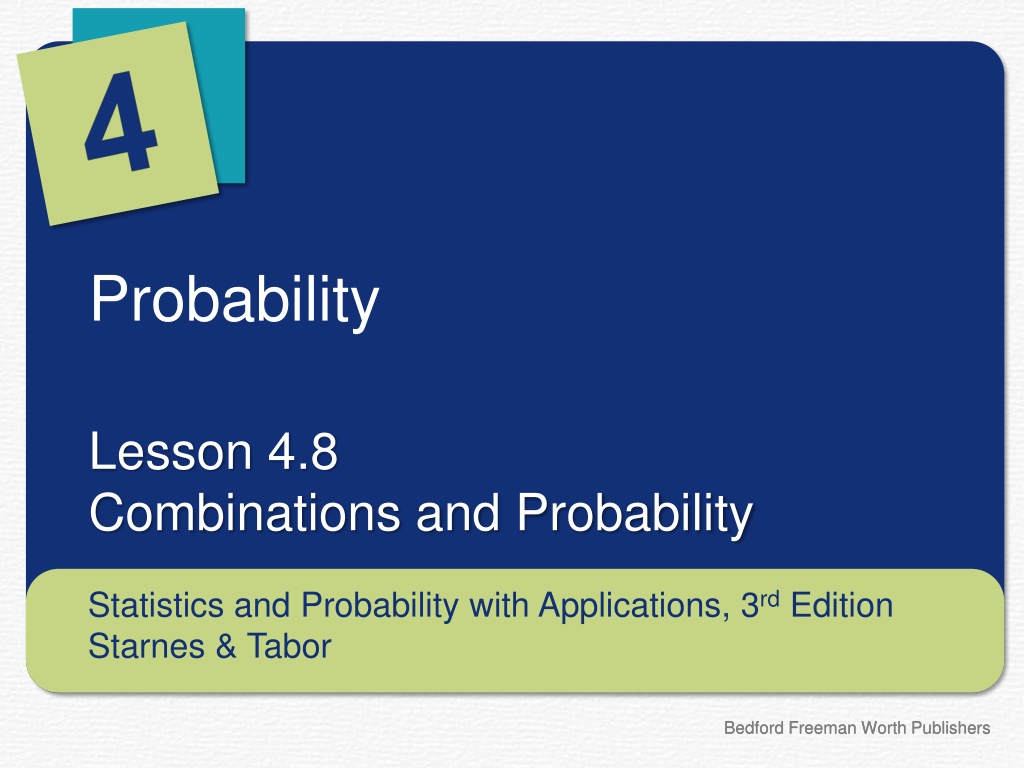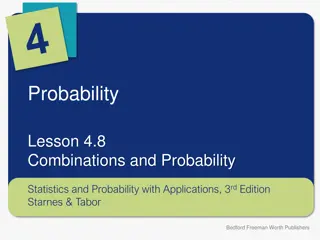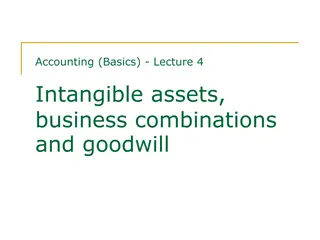Understanding Combinations and Probability in Statistics
Explore the concept of combinations and probability in statistics with a focus on calculating the number of ways to choose individuals from a group without considering order. Learn how to compute combinations, apply counting principles, and solve practical examples to deepen your understanding.
Download Presentation

Please find below an Image/Link to download the presentation.
The content on the website is provided AS IS for your information and personal use only. It may not be sold, licensed, or shared on other websites without obtaining consent from the author. Download presentation by click this link. If you encounter any issues during the download, it is possible that the publisher has removed the file from their server.
E N D
Presentation Transcript
Probability Lesson 4.8 Combinations and Probability Statistics and Probability with Applications, 3rdEdition Starnes & Tabor Starnes & Tabor Statistics and Probability with Applications, 3rd Edition Bedford Freeman Worth Publishers Bedford Freeman Worth Publishers
Combinations and Probability Learning Targets After this lesson, you should be able to: After this lesson, you should be able to: Learning Targets Compute the number of combinations of n individuals taken k at a time. Use combinations to calculate probabilities. Use the multiplication counting principle and combinations to calculate probabilities. Statistics and Probability with Applications, 3rd Edition 2 2
NEXT CONSIDER: IN HOW MANY WAYS CAN YOU CHOOSE THREE PEOPLE FROM THIS CLASS TO FORM A COMMITTEE? ASK YOURSELF: IS ORDER IMPORTANT????? Statistics and Probability with Applications, 3rd Edition 3 3
Combinations and Probability Recall that a permutation is a distinct arrangement of some group of individuals. With permutations, order matters. Sometimes, we re just interested in finding how many ways there are to choose some number of individuals from a group, but we don t care about the order in which the individuals are selected. Combinations, nCk A combination is a selection of individuals from some group in which the order of selection doesn t matter. If there are n individuals, then the notation nCk represents the number of different combinations of k individuals chosen from the entire group of n. Statistics and Probability with Applications, 3rd Edition 4 4
Combinations and Probability How to Compute Combinations You can calculate the number of combinations of n individuals taken k at a time (where k n) using the multiplication counting principle, with the formula or with the formula Statistics and Probability with Applications, 3rd Edition 5 5
Example: Combinations A state s department of transportation plans to develop a new section of interstate highway and receives 16 bids for the project. The state plans to hire four of the bidding companies. How many different combinations of four companies can be selected from the 16 bidding companies? Solution: You need to select 4 companies from a group of 16 n = 16, r = 4 Order is not important Statistics and Probability with Applications, 3rd Edition Larson/Farber 4th ed 6 6 6
Solution: Combinations 16! C = 16 4 (16 16! 12!4! 16 15 14 13 12! 12! 4 3 2 1 1820 different combinations 4)!4! = = = Statistics and Probability with Applications, 3rd Edition Larson/Farber 4th ed 7 7 7
Combinations Combinations Who screams for ice cream? Mr. Starnes loves ice cream. The local ice-cream stand offers a triple-scoop dish of ice cream. The stand has 15 different ice-cream flavors, and Mr. Starnes always chooses three different flavors for his dish. How many different sets of three flavors can Mr. Starnes choose for his dish? Statistics and Probability with Applications, 3rd Edition 8 8
Combinations and Probability The focus of this chapter is probability. Recall that when a chance process results in equally likely outcomes, the probability that event A occurs is You can use the multiplication counting principle and what you have learned about permutations and combinations to help count the number of outcomes. Statistics and Probability with Applications, 3rd Edition 9 9
Probability Using the Fundamental Counting Principle Your college identification number consists of 8 digits. Each digit can be 0 through 9 and each digit can be repeated. What is the probability of getting your college identification number when randomly generating eight digits? Larson/Farber 4th 10 Statistics and Probability with Applications, 3rd Edition 10 10 ed
Probability Using the Fundamental Counting Principle SOLUTION: Each digit can be repeated There are 10 choices for each of the 8 digits Using the Fundamental Counting Principle, there are 10 10 10 10 10 10 10 10 = 108 = 100,000,000 possible identification numbers Only one of those numbers corresponds to your ID number 1 P(your ID number) = 100,000,000 11 Statistics and Probability with Applications, 3rd Edition 11 11
From counting to probability From counting to probability What else is there for lunch? Your school cafeteria has purchased enough food for 12 different lunches over the next few weeks, 5 of which include some sort of pasta. Due to a holiday on Monday, there are only 4 school days this week. The cafeteria workers plan to randomly select 4 different lunches from the 12 lunches to serve this week. What is the probability that all 4 meals this week will include pasta? Statistics and Probability with Applications, 3rd Edition 12 12
LESSON APP 4.8 How many ways can you set up an iPod playlist? Janine wants to set up a play list with 8 songs on her iPod. She has 50 songs to choose from, including 15 songs by One Direction. Janine s iPod won t allow any song to appear more than once in a play list. 1. How many different sets of 8 songs are possible for Janine s play list? Assume that the order of the songs doesn t matter. 2. How many 8-song play lists contain no songs by One Direction? Suppose Janine decides to let her iPod select an 8-song play list at random. 3. What s the probability that none of the 8 songs is by One Direction? 4. Find the probability that exactly 2 of the 8 songs on the play list are by One Direction. Statistics and Probability with Applications, 3rd Edition 13 13
Example: Finding Probabilities A food manufacturer is analyzing a sample of 400 corn kernels for the presence of a toxin. In this sample, three kernels have dangerously high levels of the toxin. If four kernels are randomly selected from the sample, what is the probability that exactly one kernel contains a dangerously high level of the toxin? Statistics and Probability with Applications, 3rd Edition Larson/Farber 4th ed 14 14 14
Solution: Finding Probabilities The possible number of ways of choosing one toxic kernel out of three toxic kernels is 3C1 = 3 The possible number of ways of choosing three nontoxic kernels from 397 nontoxic kernels is 397C3 = 10,349,790 Using the Multiplication Rule, the number of ways of choosing one toxic kernel and three nontoxic kernels is 3C1 397C3= 3 10,349,790 3 = 31,049,370 Statistics and Probability with Applications, 3rd Edition Larson/Farber 4th ed 15 15 15
Solution: Finding Probabilities The number of possible ways of choosing 4 kernels from 400 kernels is 400C4 = 1,050,739,900 The probability of selecting exactly 1 toxic kernel is C C = (1 ) 3 1 397 C 3 P toxic kernel 400 31,049,370 1,050,739,900 4 = 0.0296 Statistics and Probability with Applications, 3rd Edition Larson/Farber 4th ed 16 16 16
Finding probabilities with combination Finding probabilities with combination Were there selection shenanigans? The student council at a local high school consists of 10 juniors and 30 seniors who are advised by a teacher. The state Association of Student Councils is holding a conference and the school has enough funds to send only 6 students. The student council advisor decided that 6 students will be selected at random to go to the conference. The advisor conducted a drawing one night after school and announced the results the next day: 4 juniors and 2 seniors would go. The seniors were concerned that the advisor may not have used random chance to decide because so few seniors were chosen. (a) Find the number of ways in which a randomly chosen group of six student council members could result in 4 juniors and 2 seniors being selected. (b) Find the probability that random selection would result in 4 juniors and 2 seniors being chosen for the conference. (c) Based on your answer to (b), is there convincing evidence that the selection process wasn t carried out by random chance? Explain. Statistics and Probability with Applications, 3rd Edition 17 17
Combinations and Probability Learning Targets After this lesson, you should be able to: After this lesson, you should be able to: Learning Targets Compute the number of combinations of n individuals taken k at a time. Use combinations to calculate probabilities. Use the multiplication counting principle and combinations to calculate probabilities. Statistics and Probability with Applications, 3rd Edition 18 18























